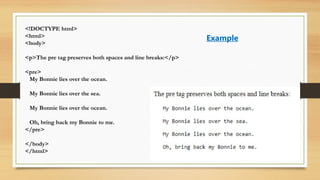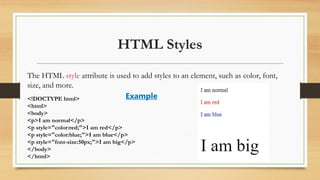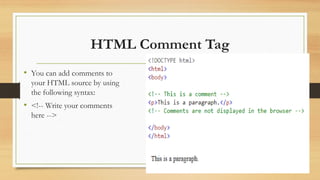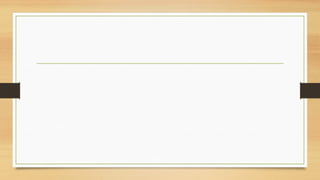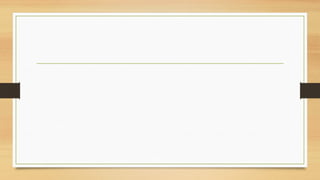html.pptx class notes to prepare html completly
- 1. Web designing with HTML & PHP By prof. Avesh gopal jonnadula
- 2. What is HTML? • HTML stands for Hyper Text Markup Language • HTML is the standard markup language for creating Web pages • HTML describes the structure of a Web page • HTML consists of a series of elements • HTML elements tell the browser how to display the content • HTML elements label pieces of content such as "this is a heading", "this is a paragraph", "this is a link", etc.
- 3. What is an HTML Element? • An HTML element is defined by a start tag, some content, and an end tag: • <tagname> Content goes here... </tagname> • The HTML element is everything from the start tag to the end tag: • <h1>My First Heading</h1> • <p>My first paragraph.</p>
- 4. EXAMPLE Note: Some HTML elements have no content (like the <br> element). These elements are called empty elements. Empty elements do not have an end tag!
- 5. Web Browsers 1. The purpose of a web browser (Chrome, Edge, Firefox, Safari) is to read HTML documents and display them correctly. 2. A browser does not display the HTML tags, but uses them to determine how to display the document:
- 7. Year Version 1989 Tim Berners-Lee invented www 1991 Tim Berners-Lee invented HTML 1993 Dave Raggett drafted HTML+ 1995 HTML Working Group defined HTML 2.0 1997 W3C Recommendation: HTML 3.2 1999 W3C Recommendation: HTML 4.01 2000 W3C Recommendation: XHTML 1.0 2008 WHATWG HTML5 First Public Draft 2012 WHATWG HTML5 Living Standard 2014 W3C Recommendation: HTML5 2016 W3C Candidate Recommendation: HTML 5.1 2017 W3C Recommendation: HTML5.1 2nd Edition 2017 W3C Recommendation: HTML5.2 HTML History
- 8. Learn HTML Using Notepad or Text Edit Web pages can be created and modified by using professional HTML editors. However, for learning HTML we recommend a simple text editor like Notepad (PC) or Text Edit (Mac). We believe that using a simple text editor is a good way to learn HTML. Follow the steps below to create your first web page with Notepad or Text Edit.
- 9. Step 1: Open Notepad (PC) Windows 8 or later: Open the Start Screen (the window symbol at the bottom left on your screen). Type Notepad. Windows 7 or earlier: Open Start > Programs > Accessories > Notepad
- 10. Step 2: Write Some HTML Write or copy the following HTML code into Notepad: <!DOCTYPE html> <html> <body> <h1>My First Heading</h1> <p>My first paragraph.</p> </body> </html>
- 11. HTML Documents 1. All HTML documents must start with a document type declaration: <!DOCTYPE html>. 2. The HTML document itself begins with <html> and ends with </html>. 3. The visible part of the HTML document is between <body> and </body>.
- 12. The <!DOCTYPE> Declaration 1. The <!DOCTYPE> declaration represents the document type, and helps browsers to display web pages correctly. 2. It must only appear once, at the top of the page (before any HTML tags). 3. The <!DOCTYPE> declaration is not case sensitive. The <!DOCTYPE> declaration for HTML5 is: <!DOCTYPE html>
- 13. HTML Headings 1. HTML headings are defined with the <h1> to <h6> tags. 2. <h1> defines the most important heading. <h6> defines the least important heading:
- 14. Example
- 15. HTML Paragraphs & HTML Links HTML links are defined with the <a> tag: Example <a href="https://www.google.com">This is a link</a> HTML paragraphs are defined with the <p> tag: Example <p>This is a paragraph.</p> <p>This is another paragraph.</p>
- 16. Example 1. The link's destination is specified in the href attribute. 2. Attributes are used to provide additional information about HTML elements.
- 17. HTML Images 1. HTML images are defined with the <img> tag. 2. The source file (src), alternative text (alt), width, and height are provided as attributes: Example <img src="w3schools.jpg" alt="W3Schools.com" width="104" h eight="142">
- 18. Example
- 19. HTML Elements 1. An HTML element is defined by a start tag, some content, and an end tag. 2. The HTML element is everything from the start tag to the end tag: 1. <tagname>Content goes here...</tagname> Examples of some HTML elements: 1. <h1>My First Heading</h1> 2. <p>My first paragraph.</p>
- 20. Nested HTML Elements 1. HTML elements can be nested (this means that elements can contain other elements). 2. All HTML documents consist of nested HTML elements. 3. The following example contains four HTML elements (<html>, <body>, <h1> and <p>):
- 21. Never Skip the End Tag • Some HTML elements will display correctly, even if you forget the end tag: Example
- 22. Empty HTML Elements 1. HTML elements with no content are called empty elements. 2. The <br> tag defines a line break, and is an empty element without a closing tag: Example
- 23. HTML is Not Case Sensitive 1. HTML tags are not case sensitive: <P> means the same as <p>. 2. The HTML standard does not require lowercase tags, but W3C recommends lowercase in HTML, and demands lowercase for stricter document types like XHTML.
- 24. HTML Attributes All HTML elements can have attributes Attributes provide additional information about elements Attributes are always specified in the start tag Attributes usually come in name/value pairs like: name="value“ The href Attribute The <a> tag defines a hyperlink. The href attribute specifies the URL of the page the link goes to:
- 25. The src Attribute The <img> tag is used to embed an image in an HTML page. The src attribute specifies the path to the image to be displayed: Example <img src="img_girl.jpg">
- 26. There are two ways to specify the URL in the src attribute: 1. Absolute URL - A. Links to an external image that is hosted on another website. a) Example: src="https://www.w3schools.com/images/img_girl.jpg". Notes: 1. External images might be under copyright. 2. If you do not get permission to use it, you may be in violation of copyright laws. 3. In addition, you cannot control external images; it can suddenly be removed or changed. 2. Relative URL - A. Links to an image that is hosted within the website. B. Here, the URL does not include the domain name. C. If the URL begins without a slash, it will be relative to the current page. A. Example: src="img_girl.jpg". If the URL begins with a slash, it will be relative to the domain. Example: src="/images/img_girl.jpg".
- 27. The width and height Attributes The <img> tag should also contain the width and height attributes, which specify the width and height of the image (in pixels): Example <img src="img_girl.jpg" width="500" height="600">
- 28. Example
- 29. •All HTML elements can have attributes •The href attribute of <a> specifies the URL of the page the link goes to •The src attribute of <img> specifies the path to the image to be displayed •The width and height attributes of <img> provide size information for images •The alt attribute of <img> provides an alternate text for an image •The style attribute is used to add styles to an element, such as color, font, size, and more •The lang attribute of the <html> tag declares the language of the Web page •The title attribute defines some extra information about an element
- 30. HTML Headings 1. HTML headings are titles or subtitles that you want to display on a webpage. 2. HTML headings are defined with the <h1> to <h6> tags. 3. <h1> defines the most important heading. <h6> defines the least important heading Note: Browsers automatically add some white space (a margin) before and after a heading. .
- 31. Headings Are Important 1. Search engines use the headings to index the structure and content of your web pages. 2. Users often skim a page by its headings. 3. It is important to use headings to show the document structure. 4. <h1> headings should be used for main headings, followed by <h2> headings, then the less important <h3>, and so on. Note: Use HTML headings for headings only. Don't use headings to make text BIG or bold.
- 32. Bigger Headings 1. Each HTML heading has a default size. 2. However, you can specify the size for any heading with the style attribute, using the CSS font-size property:
- 33. <!DOCTYPE html> <html> <body> <h1 style="font-size:60px;">Heading 1</h1> <p>You can change the size of a heading with the style attribute, using the font-size property.</p> </body> </html> Example
- 34. HTML Paragraphs 1. The HTML <p> element defines a paragraph. 2. A paragraph always starts on a new line, and browsers automatically add some white space (a margin) before and after a paragraph.
- 35. HTML Display 1. You cannot be sure how HTML will be displayed. 2. Large or small screens, and resized windows will create different results. 3. With HTML, you cannot change the display by adding extra spaces or extra lines in your HTML code. 4. The browser will automatically remove any extra spaces and lines when the page is displayed
- 36. <!DOCTYPE html> <html> <body> <p> This paragraph contains a lot of lines in the source code, but the browser ignores it. </p> <p> This paragraph contains a lot of spaces in the source code, but the browser ignores it. </p> <p> The number of lines in a paragraph depends on the size of the browser window. If you resize the browser window, the number of lines in this paragraph will change. </p> </body> </html> Example
- 37. HTML Horizontal Rules 1. The <hr> tag defines a thematic break in an HTML page, and is most often displayed as a horizontal rule. 2. The <hr> element is used to separate content (or define a change) in an HTML page 3. The <hr> tag is an empty tag, which means that it has no end tag.
- 38. <!DOCTYPE html> <html> <body> <h1>This is heading 1</h1> <p>This is some text.</p> <hr> <h2>This is heading 2</h2> <p>This is some other text.</p> <hr> <h2>This is heading 2</h2> <p>This is some other text.</p> </body> </html> Example
- 39. HTML Line Breaks 1. The HTML <br> element defines a line break. 2. Use <br> if you want a line break (a new line) without starting a new paragraph
- 40. The Poem Problem • This poem will display on a single line
- 41. <!DOCTYPE html> <html> <body> <p>In HTML, spaces and new lines are ignored:</p> <p> My Bonnie lies over the ocean. My Bonnie lies over the sea. My Bonnie lies over the ocean. Oh, bring back my Bonnie to me. </p> </body> </html> Example
- 42. Solution - The HTML <pre> Element 1. The HTML <pre> element defines preformatted text. 2. The text inside a <pre> element is displayed in a fixed-width font (usually Courier), and it preserves both spaces and line breaks
- 43. <!DOCTYPE html> <html> <body> <p>The pre tag preserves both spaces and line breaks:</p> <pre> My Bonnie lies over the ocean. My Bonnie lies over the sea. My Bonnie lies over the ocean. Oh, bring back my Bonnie to me. </pre> </body> </html> Example
- 44. HTML Styles The HTML style attribute is used to add styles to an element, such as color, font, size, and more. <!DOCTYPE html> <html> <body> <p>I am normal</p> <p style="color:red;">I am red</p> <p style="color:blue;">I am blue</p> <p style="font-size:50px;">I am big</p> </body> </html> Example
- 45. The HTML Style Attribute 1. Setting the style of an HTML element, can be done with the style attribute. 2. The HTML style attribute has the following syntax: <tagname style="property : value;"> 3. The property is a CSS property. The value is a CSS value.
- 46. Background Color The CSS background-color property defines the background color for an HTML element. <!DOCTYPE html> <html> <body style="background-color:powderblue;"> <h1>This is a heading</h1> <p>This is a paragraph.</p> </body> </html> Example
- 47. <!DOCTYPE html> <html> <body> <h1 style="background- color:powderblue;">This is a heading</h1> <p style="background-color:tomato;">This is a paragraph.</p> </body> </html> Example
- 48. Text Color 1. The CSS color property defines the text color for an HTML element: <!DOCTYPE html> <html> <body> <h1 style="color:blue;">This is a heading</h1> <p style="color:red;">This is a paragraph.</p> </body> </html> Example
- 49. Fonts The CSS font-family property defines the font to be used for an HTML element: <!DOCTYPE html> <html> <body> <h1 style="font-family:verdana;">This is a heading</h1> <p style="font-family:courier;">This is a paragraph.</p> </body> </html> Example
- 50. Text Size The CSS font-size property defines the text size for an HTML element: Text Alignment The CSS text-align property defines the horizontal text alignment for an HTML element:
- 51. <!DOCTYPE html> <html> <body> <h1 style="text-align:center;">Centered Heading</h1> <p style="text-align:left;">left paragraph.</p> <p style="text-align:right;">right paragraph.</p> </body> </html> Example
- 52. •Use the style attribute for styling HTML elements •Use background-color for background color •Use color for text colors •Use font-family for text fonts •Use font-size for text sizes •Use text-align for text alignment
- 53. HTML Text Formatting HTML contains several elements for defining text with a special meaning. Example
- 54. HTML Formatting Elements Formatting elements were designed to display special types of text: •<b> - Bold text •<strong> - Important text •<i> - Italic text •<em> - Emphasized text •<mark> - Marked text •<small> - Smaller text •<del> - Deleted text •<ins> - Inserted text •<sub> - Subscript text •<sup> - Superscript text
- 55. Example
- 57. HTML <blockquote> for Quotations The HTML <blockquote> element defines a section that is quoted from another source. Browsers usually indent <blockquote> elements.
- 58. HTML <q> for Short Quotations The HTML <q> tag defines a short quotation. Browsers normally insert quotation marks around the quotation.
- 59. HTML <abbr> for Abbreviations 1. The HTML <abbr> tag defines an abbreviation or an acronym, like "HTML", "CSS", "Mr.", "Dr.", "ASAP", "ATM". 2. Marking abbreviations can give useful information to browsers, translation systems and search-engines. 3. Tip: Use the global title attribute to show the description for the abbreviation/acronym when you mouse over the element.
- 61. HTML <address> for Contact Information 1. The HTML <address> tag defines the contact information for the author/owner of a document or an article. 2. The contact information can be an email address, URL, physical address, phone number, social media handle, etc. 3. The text in the <address> element usually renders in italic, and browsers will always add a line break before and after the <address> element.
- 63. HTML <cite> for Work Title 1. The HTML <cite> tag defines the title of a creative work (e.g. a book, a poem, a song, a movie, a painting, a sculpture, etc.). 2. Note: A person's name is not the title of a work. 3. The text in the <cite> element usually renders in italic.
- 65. HTML <bdo> for Bi-Directional Override 1. BDO stands for Bi-Directional Override. 2. The HTML <bdo> tag is used to override the current text direction:
- 67. HTML Comment Tag • You can add comments to your HTML source by using the following syntax: • <!-- Write your comments here -->
- 68. Hide Content • Comments can be used to hide content. • This can be helpful if you hide content temporarily:
- 69. Hide Inline Content • Comments can be used to hide parts in the middle of the HTML code.
- 70. HTML Colors • HTML colors are specified with predefined color names, or with RGB, HEX, HSL, RGBA, or HSLA values.
- 71. Background Color • You can set the background color for HTML elements:
- 72. Text Color • You can set the color of text: Hello World <h1 style="color:Tomato;">Hello World</h1> <p style="color:DodgerBlue;"> Hello World</p> <p style="color:MediumSeaGreen;"> Hello World</p>










































